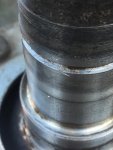BMarino
New member
Hi everyone.
My truck is a 1994 4WD Pickup Xtra Cab, 22RE manual.
I need help on a dilemma. Here's the issue: when replacing the rear axle shaft bearings, one of the axles was nicked when removing the retainer. The nick is hardly 0.5 mm deep. I don't use my truck for wheeling, but I do use it to haul stuff (heavy stuff sometimes) and on rough offroading, mainly traversing forest service roads and rocky paths and river crossings on the sierras in Mexico.
Here's the nick I'm talking about:


Now, I read everywhere that "any" nick on the axle shaft surface originates a stress riser spot which can eventually cause the axle to fail. So I went on and after months of searching (haven't moved my truck once since then), found a spare rear axle shaft in a junkyard. It is visually without flaw, except for this:

For reasons I can't imagine, it was smashed at those spots. Now, I don't know if this is something which could cause any issues, but it got me thinking if it is really the best idea to replace my original axle shaft with this one. For one, I have no idea on what king of abuse an axle shaft sourced from a junkyard has been subjected to (even if visually it seems flawless). Additionally, and here I'm purely guessing as I'm no engineer, it jumped on my mind that maybe it is important to have axle shafts on both sides of the differential with the same accumulated metal fatigue. If I replace one of them, this would likely no longer be the case.
So the dilemma is:
Is it safer to stick with my original, nicked, axle shaft, obviously if, and only if, the nick on it isn't really that of an issue (?)
OR
Is it safer to eliminate the risk that nick represents, and replace the original shaft with the junkyard rear axle shaft (?)
In short, which is a greater of a risk:
Trusting my nicked axle shaft, or trusting an apparently flawless axle shaft, with an unknown history of possible abuse?
I'll greatly appreciate any help or advice given!
My truck is a 1994 4WD Pickup Xtra Cab, 22RE manual.
I need help on a dilemma. Here's the issue: when replacing the rear axle shaft bearings, one of the axles was nicked when removing the retainer. The nick is hardly 0.5 mm deep. I don't use my truck for wheeling, but I do use it to haul stuff (heavy stuff sometimes) and on rough offroading, mainly traversing forest service roads and rocky paths and river crossings on the sierras in Mexico.
Here's the nick I'm talking about:


Now, I read everywhere that "any" nick on the axle shaft surface originates a stress riser spot which can eventually cause the axle to fail. So I went on and after months of searching (haven't moved my truck once since then), found a spare rear axle shaft in a junkyard. It is visually without flaw, except for this:

For reasons I can't imagine, it was smashed at those spots. Now, I don't know if this is something which could cause any issues, but it got me thinking if it is really the best idea to replace my original axle shaft with this one. For one, I have no idea on what king of abuse an axle shaft sourced from a junkyard has been subjected to (even if visually it seems flawless). Additionally, and here I'm purely guessing as I'm no engineer, it jumped on my mind that maybe it is important to have axle shafts on both sides of the differential with the same accumulated metal fatigue. If I replace one of them, this would likely no longer be the case.
So the dilemma is:
Is it safer to stick with my original, nicked, axle shaft, obviously if, and only if, the nick on it isn't really that of an issue (?)
OR
Is it safer to eliminate the risk that nick represents, and replace the original shaft with the junkyard rear axle shaft (?)
In short, which is a greater of a risk:
Trusting my nicked axle shaft, or trusting an apparently flawless axle shaft, with an unknown history of possible abuse?
I'll greatly appreciate any help or advice given!


